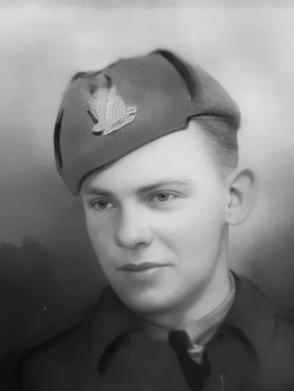Bergen-Op-Zoom
Canadian War Cemetery

copyright © Wartime Heritage Association
Website hosting courtesy of Register.com - a web.com company
Wartime Heritage
ASSOCIATION
Remembering World War II
Name:
Robert Kenneth Vidito
Rank:
Private
Service Number:
F/57239
Service:
Calgary Highlanders,
Royal Canadian Infantry Corps
Date of Birth:
January 10, 1924
Place a Birth:
Bridgetown, Annapolis County, Nova Scotia
Date of Enlistment:
July 26, 1943
Place of Enlistment:
Halifax, Halifax County, Nova Scotia
Address at Enlistment:
Digby, Digby County, Nova Scotia
Age at Enlistment:
19
Height:
5 feet, 9 ¼ inches
Complexion:
Medium
Eye Colour:
Blue
Hair Colour:
Light brown
Occupation:
Farmer
Marital Status:
Single
Religion:
United Church of Canada
Next of Kin:
Beatrice Vidito (Mother), Digby, NS
Date of Death:
October 9, 1944
Age:
20
Cemetery:
Bergen-op-Zoom Canadian War Cemetery, Netherlands
Grave:
Section 12, Row B, Grave 7
Commemorated on Page 469 of the Second World War Book of Remembrance
displayed in the Memorial Chamber of the Peace Tower in Ottawa on October 8
Robert Kenneth Vidito was the son of William Wilbert Vidito (1891-1966) and Beatrice Victoria
(Marshall) Vidito (1899-1988), of Digby, Nova Scotia. Robert had five brothers, Walter William Vidito
(1922-1965), Clifford Eugene Vidito (1930-2024), Charles (1934-2013) Vidito, Nelson Bertram Vidito
(1936-2012), and Earl George Vidito, and three sisters, Patricia, Edith Vidito (1932-2022) and Lois
Vidito. Robert also had a half-brother, Stanley ‘Stan Richard Vidito (1917-1993), from his mother’s
marriage to her first husband Aubrey Stanley Vidito (1897-1918), who died of illness serving in WWI
(interred at the Haifa War Cemetery in Palestine (Israel today).
Robert completed the 5th grade in school but left school to work. He worked for an oil company
fueling boats, painted and did other odd jobs with his father, worked at dry cleaning in a local tailor
shop, was an express truck driver, helped his father coaling-up train engines on the Dominion Atlantic
Railway (DAR), and worked as a farmer before the war.
After enlisting in July of 1943, Robert completed basic training at Canadian Infantry Basic Training
Centre (CIBTC) No. 60 (Camp 60) from August 6 to October 7, 1943, and advanced training at Canadian
Infantry Training Centre No. 14 at Aldershot in Kings Co., NS from October 8 to November 16, 1943. He
arrived in England January 5, 1944, and transferred to France on August 31, 1944.
Securing a major port for the Allies was of vital concern after the Normandy Campaign. Antwerp had
the second largest port facilities in Europe, with 45 kilometres of docks.
After the failure to clear many of the Channel Ports in September 1944, the need for port facilities
north of Normandy grew acute. Allied supply lines were moving farther and farther away from
Normandy, where most of their supplies were landing in Europe, resulting in very long supply runs by
truck to the Allied armies. Antwerp had fallen with intact port facilities in September, however, the
waterway leading to Antwerp, the Scheldt Estuary, was lined with German forces, and in particular
heavy coastal batteries on Walcheren Island prevented any Allied supply ships from approaching the
Scheldt to land supplies in Antwerp.
First Canadian Army was given the task, as the
left-most of the Allied armies on the continent, of
clearing the Scheldt Estuary. Private Robert
Kenneth Vidito, serving with the Calgary
Highlanders, was killed in action in the Battle of
the Scheldt on October 9, 1944, and is interred at
the Bergen-op-Zoom Canadian War Cemetery.
Robert Kenneth Vidito






- World War I - Menu
- WWI Stories and Articles
- Photos - Yarmouth Soldiers
- Selection of World War I Songs
- WWI Casualties of Yarmouth, NS
- Those Who Served - Yarmouth, NS
- WWI Casualties Digby Co. NS
- WWI Casualties Shelburne Co. NS
- Merchant Mariners (1915) Yarmouth, NS
- Canadian Forestry Corps - Non Yarmouth Birth/Residence Enlistments
- US Draft Registry - Yarmouth NS Born


- World War II - Menu
- WWII Stories and Articles
- Telegraphist Air Gunners
- WWII Casualties of Nova Scotia
- US Casualties with NS Connection
- Far East/Pacific Casualties with NS Connection
- Merchant Navy Casualties Nova Scotia
- Nova Scotia WWII Casualties Holten Canadian War Cemetery
- D-Day Casualties - Nova Scotia
- CANLOAN Program Casualties - Nova Scotia
- Battle of the Bulge Casualties - Nova Scotia
- WWII Casualties Yarmouth NS
- Yarmouth Casualties - RCAF RAF Canadian Army WWII
- Yarmouth Co., Marriages WWII
- Casualties Non-Born/Residents with Connection to Yarmouth Co., Nova Scotia.
- WWII Casualties Digby Co., NS
- Non-Nova Scotian WWII Casualties Buried in Nova Scotia
- WWII RCAF Casualties Aged 16-18
- Brothers/Sisters Who Served - World War II













